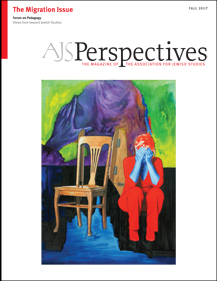Dear Colleagues,
"My father was a wandering Aramean; he went down to Egypt and sojourned there …" (Deuteronomy 26:5)—so begins the ancient liturgy of the firstfruits, with its rehearsal of Israel's sacred history, so much of which is a narrative of migration. The story of the Jews is a tale of people in motion: voluntary or compelled; legal or illicit; gradual or abrupt; as an individual or as part of a larger communal movement. Deuteronomy writes of ancestral movement in the past tense, anticipating a time of settlement and stability, of routine and cyclical harvest holidays and sacred convocations, but in truth the wandering never ceased.
In this issue, we approach the subject of migration—of people in motion—from a variety of perspectives. Classic narratives, whether of ancient exile or modern immigration, are challenged, while "roads less traveled" are here brought to light. Laguerre, Cohen, and Gruen, while writing of vastly different time periods, draw our attention to the lexicon of migration: Diaspora and exile, multiple centers and fluid peripheries, and a plethora not only of "Jerusalems" but even, as Cohen points out in his exploration of Syrians, Eritreans, and other refugee and migratory populations in a post-Holocaust world, of "Jews." Of course, in "classical" Judaism, there is only one Jerusalem, and Zion constituted the center of gravity of Jewish migration. Alroey addresses a locus classicus of that understanding: the mythologies surrounding the Second Aliyah, and the messy reality beneath the gloss. Moreno's essay, in turn, reminds us that the narrative of the "rescue" of the Jews of Tangier denies the very real agency of these populations. Burnett brings us to the quotidian world of sound, reminding us of the ways in which migrants create "home" in the most fundamental of ways, while Zemel highlights how photography "paused" the urgent momentum of migration and froze it as a moment in time. Narratives of immigration to the United States are revisited and revealed as more complex than commonly held: Doron highlights the startling youthfulness of the migrants of 1870–1924; Garland recovers stories of illegal Jewish immigration across the Texas border—harrowing narratives of human smuggling that remain part of daily life today. Boum explores the dynamic and developing identities of Moroccan Jews in Los Angeles, where language and history play out on the canvas of ritual and liturgy; and Kaminsky draws our attention not only to the power of art as a way of approaching political history, but to how our own stories shape us as scholars. Of course, migrations were often ongoing, even elliptical: Roby recounts individuals who challenged the ideas of aliyah (ascent to Israel) and yeridah (descent away from the Promised Land) by leaving Israel for Berlin and Iraq; and Mays highlights the distinctive peripatetic pathways of Sephardic Jews in the twentieth century and illustrates more broadly the lack of congruence among citizenship, nationality, residence, and identity. As Gilman reminds us, even the most deliberate of "cosmopolitans" did not necessarily abandon their particularisms. Taken together, these essays conjure a vast web of human motion: anything but linear, sometimes movement toward and often flight from, occasionally as individuals and at times en masse.
When we conceived of this issue, the migrations of non-Jews were as much on our minds as any Jewish wanderings, past or present. Issues of immigration to the United States (legal and otherwise) as well as the Syrian refugee crisis constituted daily topics of conversation and calls to activism, in the hallways and in our classrooms. The causes, experiences, and consequences of migration confronted us with great urgency, and we found ourselves reaching into the Jewish experience for analogies and insights. As fate would have it, within days of contacting prospective contributors for this issue, the first "travel ban" was announced, lending our choice of topic unexpected urgency and relevance. A protestor at an airport rally in Raleigh, North Carolina, could be seen the next day holding a sign: "My ancestor was a Syrian refugee (Deuteronomy 26:5)"—a translation that takes some liberty with language and yet remains true to the story of migration told, however episodically, in what follows.
Jonathan M. Hess
University of North Carolina at Chapel Hill
Laura S. Lieber
Duke University

